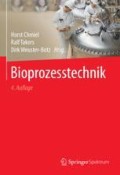Zusammenfassung
Mikroorganismen (Bakterien, Hefen, Pilze, Mikroalgen) und Gewebezellen (tierische Zellen, pflanzliche Zellen) werden neben isolierten Enzymen als Biokatalysatoren in vielfältiger Weise in der industriellen Produktion eingesetzt. Die quantitative Kenntnis der Reaktionsgeschwindigkeiten dieser Biokatalysatoren (Substratverbrauch, Wachstum und Produktbildung) in Abhängigkeit der Reaktionsbedingungen ist von zentraler Bedeutung für Auslegung und Betrieb von Bioreaktoren. Die grundlegenden Konzepte zur Wachstumsmodellierung von Mikroorganismen und Zellen werden in diesem Kapitel beschrieben.
Literatur
Müller S (2007) Modes of cytometric bacterial DNA pattern: A tool for pursuing growth. Cell Proliferat 40:621–639
Zwietering MH, Jongenburger I, Rombouts FM, van’t Riet K (1990) Modeling of the bacterial growth curve. Appl Environ Microbiol 56:18575–1881
Bellgardt K-H (1991) Cell models. In: Rehm H-J, Reed G, Pühler A, Stadler P, Schügerl K (Hrsg) Biotechnology, Vol. 4, Measuring, Modeling and Control, VCH, Weinheim, S 267–298
Monod J (1942) Recherches sur la croissance des cultures bacteriennes, 2. Aufl. Hermann, Paris
Andrews JF (1968) A mathematical model for continuous culture of microorganisms utilizing inhibitory substrates. Biotechnol Bioeng 10:707
Levenspiel O (1980) The Monod equation: a revisit and a generalization to product inhibition situations. Biotechnol Bioeng 22:1671–1687
Ierusalimski ND, Neronova NM (1965) Quality concentration of exchange products as dependent on rate of growth of microorganisms. Doklady Akademii Nauk SSSR 161:1437
Edwards VH (1970) The influence of high substrate concentrations on microbial kinetics. Biotechnol Bioeng 12:679
Pirt SJ (1965) The maintenance energy of bacteria in growing cultures. Proc R Soc Ser B 163:224
Tsao GT, Hanson TP (1975) Extended Monod equation for batch cultures with multiple exponential phases. Biotechnol Bioeng 12:1591–1598
Roels JA (1983) Energetics and kinetics in biotechnology. Elsevier, Amsterdam
Gaden EL (1959) Fermentation process kinetics. J Biochem Microbiol Techn Eng 1:413–429
Takors R, Wiechert W, Weuster-Botz D (1997) Experimental design for the identification of macrokinetic models and model discrimination. Biotech Bioeng 56:564–576
Nielsen J (1993) A simple morphologically structured model describing the growth of filamentous microorganisms. Biotechnol Bioeng 41:715–727
De Ory I, Romero LE, Cantero D (1998) Modelling the kinetics of growth of Acetobacter aceti in discontinuous culture: influence of the temperature of operation. Appl Microbiol Biotechnol 49:189û193
Olsen KN, Budde BB, Siegumfeldt H, Rechinger KB, Jakobsen M, Ingmer H (2002) Noninvasive measurement of bacterial intracellular pH on a single-cell level with green fluorescent protein and fluorescence ratio imaging microscopy. Appl Environ Microbiol 68:4145–4147
Shimamoto T, Inaba K, Thelen P, Ishikawa T, Goldberg EB, Tsuda M, Tsuchiya T (1994) The NhaB Na+/H+ antiporter is essential for intracellular pH regulation under alkaline conditions in Escherichia coli. J Biochem 116:285–290
Nicholls DG, Fergusan SJ (1992) Bioenergetics 2. Academic Press, London
Ackermann T (1992) Physikalische Biochemie. Springer, Berlin
Lehninger AL, Nelson DL, Cox MM (1994) Prinzipien der Biochemie, 2. Aufl. Spektrum Akademischer Verlag, Heidelberg
Schuhmacher T, Löffler M, Hurler T, Takors R (2014) Phosphate limited fed-batch process: Impact on carbon usage and energy metabolism in Escherichia coliEscherichia coli. J Biotechnol 190:96–104
Pyle AM (1996) Role of metal ions in ribozymes. Met Ions Biol Syst: 479–520
Silver S (1998) Genes for all metalls – A bacterial view of the periodic table. The 1996 Thom Award Lecture. J Ind Microbiol Biotechnol 20:1–12
Otterbach H (1974) Äthylendiamin-tetraessigsäure. In: Ullmanns Encyklopädie der technischen Chemie, Bd 8, 4. Aufl. Verlag Chemie, Weinheim
Silver S, Perry RD (1982) Bacterial inorganic cation and anion transport systems. In: Martonosi AN (Hrsg) Membranes and transport, Bd 2. Plenum Press, New York, S 115–121
Jasper P, Silver S (1977) Magnesium transport in microorganisms. In: Weinberg ED (Hrsg) Microorganisms and minerals, Marcel Dekker, Inc. New York, S. 7–47
Marks J (1993) Biological functions of vitamins. In: Ottaway PB (Hrsg) The technology of vitamins in food, Chapman & Hall, London
Zabriskie DW, Armiger WB, Phillips DH, Albano PA (1982): Trader’s guide to fermentation media formulation. Traders protein, P.O. box 8407, Memphis, Tennessee 38108, USA
Weuster-Botz D (2000) Experimental design for fermentation media development: Statistical design or global random search? J Bioscience Bioeng 90:473–483
Khuri AI, Cornell JA (1987) Response surfaces. Marcel Dekker, New York
Holland JH (1975) Adaption in natural and artificial systems. The University of Michigan Press, Ann Arbor
Link H, Weuster-Botz D (2006) Genetic algorithm for multi-objective experimental optimization. Bioprocess Biosyst Eng 29:385–390
Sprave J (1995) Evolutionäre Algorithmen zur Parameteroptimierung. at 43:110–117
Author information
Authors and Affiliations
Corresponding author
Editor information
Editors and Affiliations
Rights and permissions
Copyright information
© 2018 Springer-Verlag GmbH Deutschland, ein Teil von Springer Nature
About this chapter
Cite this chapter
Weuster-Botz, D., Takors, R. (2018). Wachstumskinetik. In: Chmiel, H., Takors, R., Weuster-Botz, D. (eds) Bioprozesstechnik. Springer Spektrum, Berlin, Heidelberg. https://doi.org/10.1007/978-3-662-54042-8_2
Download citation
DOI: https://doi.org/10.1007/978-3-662-54042-8_2
Published:
Publisher Name: Springer Spektrum, Berlin, Heidelberg
Print ISBN: 978-3-662-54041-1
Online ISBN: 978-3-662-54042-8
eBook Packages: Life Science and Basic Disciplines (German Language)

